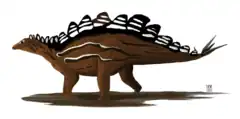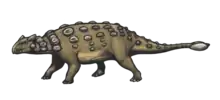Polacanthoides (meaning Polacanthus like) as named as a genus of nodosaurid dinosaur from Europe.[1] the fossils date to the Early Cretaceous, between 140 and 135 million years ago from what is now England. The genus and species were named by Franz Nopcsa von Felső-Szilvás in 1928. The syntype specimens are NHMUK PV OR2584, a left scapula from the Wealden Group, and NHMUK PV R1106, R1107, a humerus plus tibia both from the Wessex Formation. Due to the disparate locations of the syntypes, it is a junior synonym of both Hylaeosaurus and Polacanthus and was based on a chimera of skeletal elements. Polacanthoides is now considered an invalid name.[2]
See also
References
- ↑ Nopcsa, F. (1928), "Palaeontological notes on reptiles." Geologica Hungarica, Series Palaeontologica, tomus, 1, -Pasc. 1, p. 1-84
- ↑ Raven, T.J.; Barrett, P.M.; Pond, S.B.; Maidment, S.C. (2020). "Osteology and Taxonomy of British Wealden Supergroup (Berriasian–Aptian) Ankylosaurs (Ornithischia, Ankylosauria)". Journal of Vertebrate Paleontology. 40 (4). doi:10.1080/02724634.2020.1826956.
This article is issued from Wikipedia. The text is licensed under Creative Commons - Attribution - Sharealike. Additional terms may apply for the media files.

